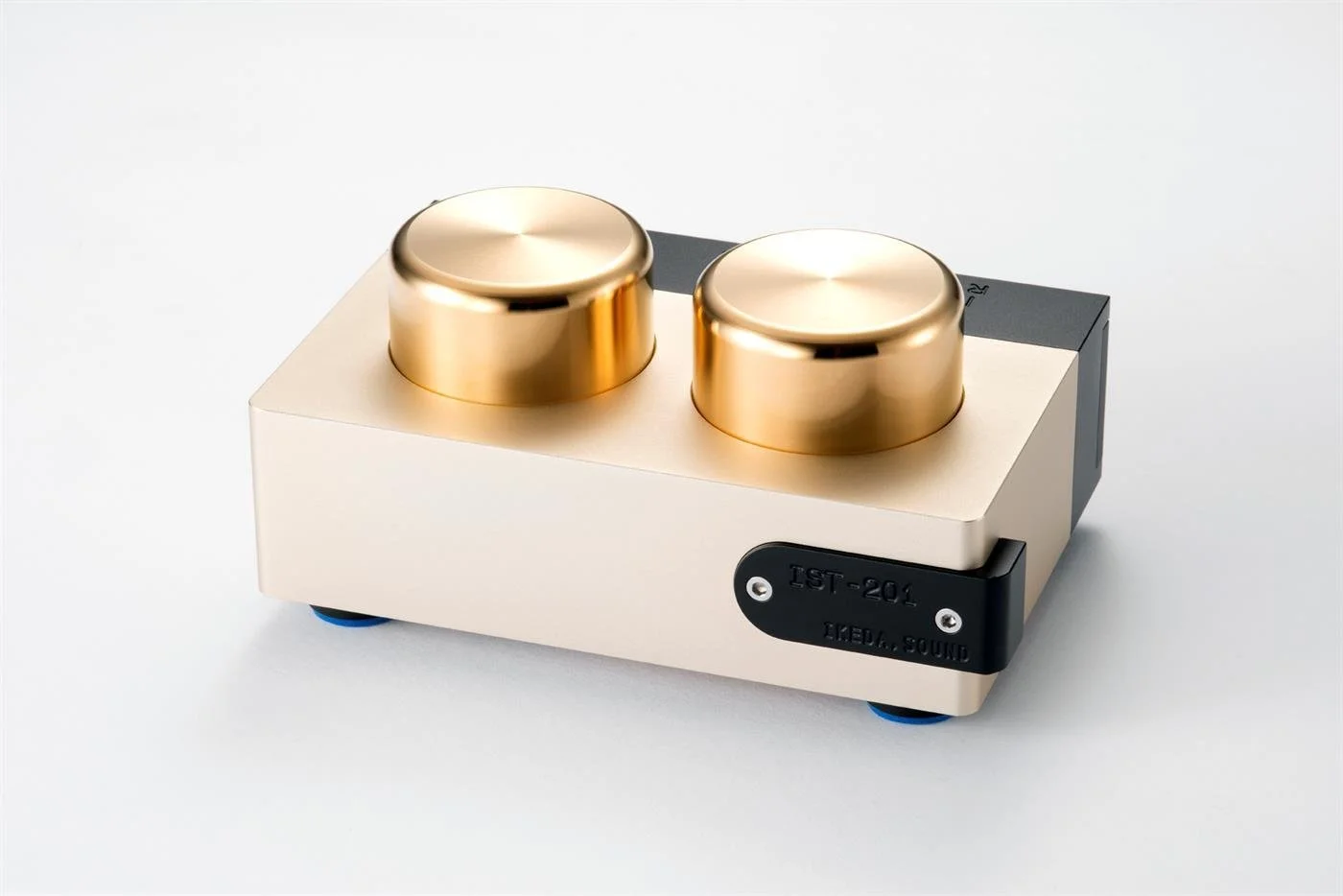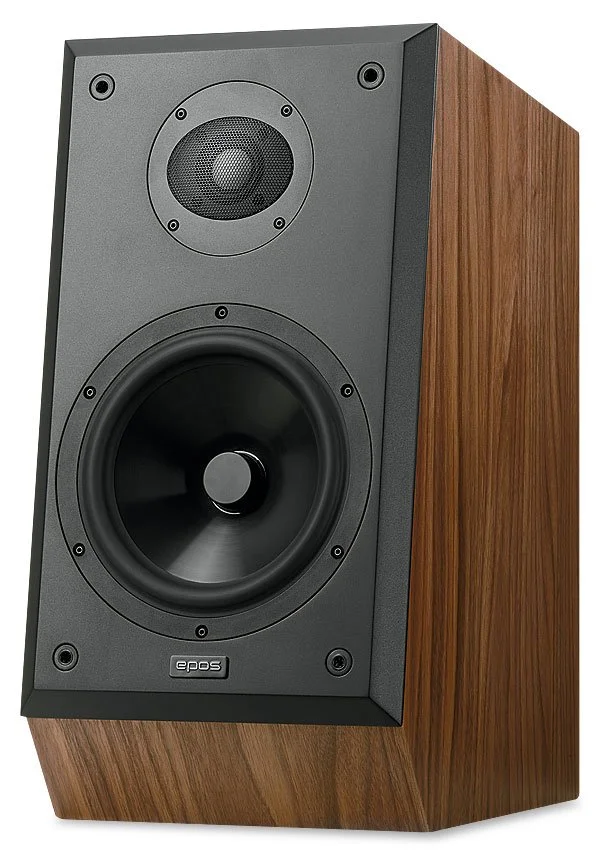IKEDA IST-201 Step-Up Transformer
It would be instructive to read my review of the first Step-Up Transformer I reviewed, the EAR MC4.
I’ll use the same introductory paragraph for the IKEDA IST-201 review as the technology (not sound) is the same.
I’m new to SUTs, better known as Step-Up Transformers, small passive boxes that enable your moving coil (MC) cartridge and phono stage to work to their fullest potential. Many MC cartridges have very low output, much lower than a moving magnet cartridge; as such, they need more gain from a phono stage to be played at normal listening levels. While many fine phono stages have a section specific for moving coils, the technology used, FETs or tubes, often adds noise to the system. A well-designed and wound Step-Up Transformer can lower the noise floor, resulting in better sound.
Henley Audio offers a detailed explanation of the science: Where phono stages, as part of their signal amplification, will have a constant resistive input impedance, Step-Up Transformers have a frequency-dependent input impedance. Step-Up Transformers are also passive (i.e. not mains-powered) devices, reducing the chance of external electrical forces impacting the cartridge's low output signal. The result of a Step-Up Transformer's design is that they can amplify the MC output level and produce less harmonic distortion as the frequency rises - which is the opposite effect of a phono stage. This results in a cleaner electrical signal and more dynamic sound performance from the cartridge in a wider, deeper soundstage.
On to the IKEDA IST-201 Step-Up Transformer, a glorious-looking, small passive device with an MSRP of USD 5400.
My Use
I’d like to thank David Jensen of Red Leaf Audio for providing the IKEDA IST-201.
It’s a beautifully crafted nugget of a box in Champagne (which matches my Phasemation EA-350 Phono Amplifier perfectly) with two small gold silos atop housing the transformers.
Connection is the same as the EAR MC4 except for impedance input choices. The EAR gives you four impedance inputs—thus the ability to use a wide variety of cartridges. The IKEDA does not have a catholic philosophy. One input only. Only carts with an impedance between 1 ohm - 6 ohms may apply. The 201 is laser-focused on getting one thing right with one type of low-output MC. It does this with frightening accuracy and aplomb. As such, very careful cartridge matching is imperative. For my 4 ohm Phasemation PP-2000 MC Phono Pickup Cartridge, the IST-201 presented zero problems. But you would be wise to consult your dealer or distributor Red Leaf if you are not exactly sure of the compatibility.
The analog front end was my 2024 reference system.
Features
The 201 is machined from a solid aluminum block. The rear of the unit has four rhodium-plated, matched RCA connectors (output/input). The housing is made of high-efficiency core materials and Mu-metal is used for its very effective magnetic shielding.
The IKEDA IST-201 also features a floating ground switch on the rear panel. Interestingly, John Stratton of Pure Fidelity who sent me his 201 before I received the review unit, mentioned the possibility of a hum when grounded. He mentioned if it did, to ground the phono cable to the phono stage rather than the rear of the IKEDA. I did hear a very rare, brief hum when touching the cueing lever of my Origin Live Enterprise MK4 Tonearm…a moment then gone, and never during playback. It has not been bothersome and is so sporadic, I kept the ground attached to the 201. The floating ground switch made no difference.
Specifications
Input Impedance: 2 ohm - 6 ohm
Load Impedance: Over 47k ohm
Channel Separation: Over 90dB (1kHz)
Frequency Response: 10Hz - 100kHz, ±0.6dB, 3ohm/47k ohm
Step-Up Rate: 26dB
Channel Balance: Within 0.1dB (1kHz)
Dimensions: 5.5 x 3.7 x 2.2" (WxDxH)
Weight: 3.74 lbs.
Sound
Break in on the IKEDA is as important as the other two SUTs I’ve been auditioning; probably even more so. The 201, like the MC4, sounds great out of the box—actually, even more impressive than the MC4. But be patient. The glorious detail and timbral cues the IKEDA adds take their time to appear. And like the EAR (and Allnic Audio AUT-8000 silver-wound MC step-up, I’m also reviewing—USD 4800), very enjoyable as hitherto unknown details make themselves known from records I’ve heard many times over. I’d say the 201 is still unveiling musical truths after 50 hours of use. Greatness takes time.
As I was reviewing three SUTs concurrently, I used much of the same repertoire as comparative studies.
So I began the same as the MC4 audition, with the fleet, delightful “Queen Mab” Scherzo from Berlioz’s 1839 masterpiece Roméo et Juliette. Beguiling delicacy and that sprinkling of magic fairy dust I mention in the EAR review, but with even more sweetness and transparency. This was surprising and occurred after several hours of playtime. The improvement over the EAR MC4 in percent? Quantifying this stuff is tough. But I’d guess the EAR improved my Phasemation EA-350 by 5% and the IKEDA by 10%. These are big numbers when you think in audiophile terms. I was very impressed and moved by the IKEDA’s performance. Fairy dust, plus!
My recent video about DG chamber music records included very enjoyable listening sessions with these very fine, underrated DGs sounding sweet, dynamic, transparent and altogether exceptional. The IKEDA helped in my determination for the video. The 201’s very transparent soundstage allowed me to critique the always unnamed recording location. But compared to the below-average sound on DG orchestral LPs, the IKEDA was a great help with the recognition of texture, inner lines, and a coherent soundstage with razor-sharp imaging.
Particularly wonderful was the exceptional Boston Symphony Chamber Players (all first chairs from the BSO) LP of music by Claude Debussy, a Günter Hermanns recorded gem—transparent soundstage with no odd perspectives. Most importantly, all tonal cues from the myriad of timbres the six players use are heard in the most beautiful diaphanous sound. The great American Concertmaster, the dean for many years, Joseph Silverstein, was a specific case in his performance of the wonderful Sonata for Violin and Piano in G minor (1917). I know the record very well, played on umpteen phono stages and never have I heard the inner workings of Silverstein’s multi-faceted, glorious Stradivarius as through the IKEDA-based system. Both vibrato and portamento were tangible with his beautiful tone in place. The IKEDA sound left this listener tingling many times.
And to hear the deepest pluck, articulation and resonance from Ann Hobson’s harp on Debussy’s sublime Sonata for Flute, Viola and Harp of 1915 was also the first time. The IKEDA truly transformed this record from somewhat audiophile to legendary status and is now included on the Audiophilia Dream List. Like all benchmark high-end audio gear, it makes you hear well-worn LPs anew.
The 201 also sprinkled its magic elixir on digitally-sourced records. So Caelen Cardelo’s brilliant ingenue jazz piano playing and Steely Dan’s Two Against Nature retained analogue warmth but highlighted the detail that really good remastering engineers like Bob Ludwig and Scott Hull can extract from a digital file.
Conclusion
Other than the King of Transformer Winding, the late Tim de Paravicini (EAR MC4), the super high-end Japanese manufacturers are meticulous in their standards winding transformers. It shows in their reputations (IKEDA, Air Tight, Phasemation, etc). I have not yet had the pleasure of hearing the Air Tight models or Phasemation, but the IKEDA transformer recipe is exceptional in every way. And while the EAR is a steal at USD 2500, the IKEDA is a fair chunk of change higher at USD 5400. Is the 201’s increase in performance worth the extra outlay? You betcha! It’s magnificent and it’s staying. Very highly recommended.
Further information: IKEDA SoundLabs









![Ellington Indigos IMPEX 45 RPM Reissue [2024]](https://images.squarespace-cdn.com/content/v1/55787f0ae4b02f0501debbeb/1718387154154-VHGCIIQSRRC3LTS5WBZE/IMG_1944.jpeg)
